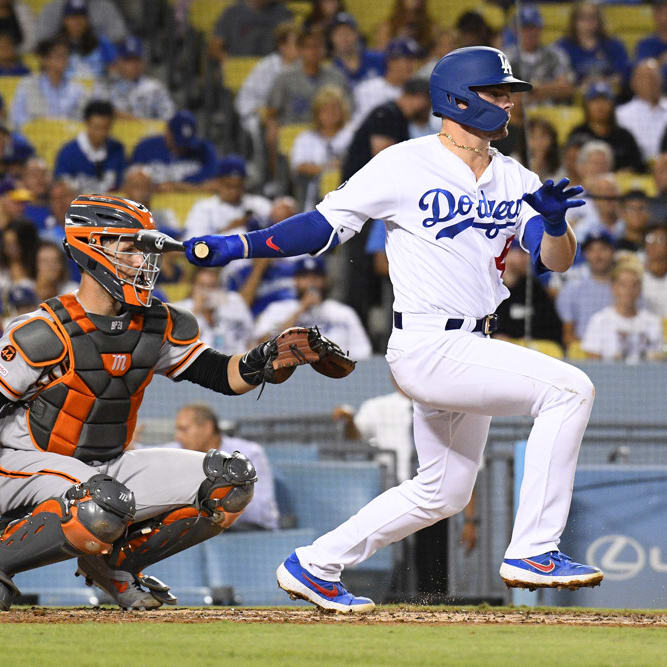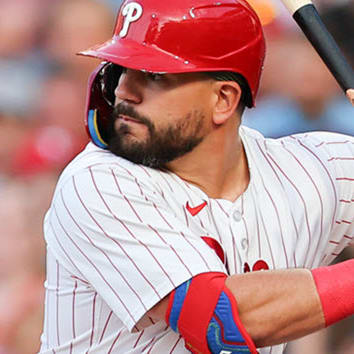Trevor Bauer, RHP, Cleveland Indians - Things looked promising for Bauer entering the 2012 season. He was the third overall pick in the draft the year before, had already made his professional debut with seven starts between High-A and Double-A in 2011, was rated the ninth-best prospect in all of baseball by Baseball America, and most people expected him to be the first player from the 2011 draft to debut in the majors (which, it turns out, he was). Still, the year simply did not go how he would have liked as he battled control issues in the minors (61 walks in 130.1 innings) before suffering a groin injury in his first start in the majors. Bauer tried to pitch through the injury, the results were ugly (16.1 innings, 14 hits, 11 earned runs, two homers, 17:13 K:BB), and the Diamondbacks seemed pleased with rookie contributors Wade Miley, Patrick Corbin, and Tyler Skaggs. Arizona also seemed nonplussed by Bauer at the end of the year as there were rumblings about him not making adjustments that the coaching staff and teammates wanted, followed by one of the club's managing general partners throwing him under the bus in the local papers. As someone who was in Bauer's first big media scrum and spent some time in the Arizona clubhouse during spring training, I am still trying to figure out how Bauer went from third overall pick to traded for Didi Gregorius so quickly. It seems that the organization
Trevor Bauer, RHP, Cleveland Indians - Things looked promising for Bauer entering the 2012 season. He was the third overall pick in the draft the year before, had already made his professional debut with seven starts between High-A and Double-A in 2011, was rated the ninth-best prospect in all of baseball by Baseball America, and most people expected him to be the first player from the 2011 draft to debut in the majors (which, it turns out, he was). Still, the year simply did not go how he would have liked as he battled control issues in the minors (61 walks in 130.1 innings) before suffering a groin injury in his first start in the majors. Bauer tried to pitch through the injury, the results were ugly (16.1 innings, 14 hits, 11 earned runs, two homers, 17:13 K:BB), and the Diamondbacks seemed pleased with rookie contributors Wade Miley, Patrick Corbin, and Tyler Skaggs. Arizona also seemed nonplussed by Bauer at the end of the year as there were rumblings about him not making adjustments that the coaching staff and teammates wanted, followed by one of the club's managing general partners throwing him under the bus in the local papers. As someone who was in Bauer's first big media scrum and spent some time in the Arizona clubhouse during spring training, I am still trying to figure out how Bauer went from third overall pick to traded for Didi Gregorius so quickly. It seems that the organization put its needs and the off-field issues they had with Bauer ahead of what is still an incredible high-ceiling talent. It's as if Arizona forgot that Bauer was still their organization's top prospect who also won their Pitcher of the Year award for his performance in the minors last season.
Despite the groin injury and reduced velocity in his brief stint in the majors, Bauer has no significant injury history, and even with a very heavy workload in college (not to mention his extensive long toss regimen) his stuff never waned. Assuming his health and stuff (92-95 mph with the fastball, touching 97) return, Bauer's biggest challenge will be his command. Too often Bauer finds himself unable to simply drop one of his many secondary pitches in the zone for a strike. This is an adjustment he will have to make as big leaguers are not chasing his big breakers out of the zone the way college (and minor league) hitters did. His value for 2013 and in keeper leagues remains high because he is in an organization that is going to do everything to see him succeed and he has a clear path to a rotation spot. I still project him as a future No. 2 starter and don't consider him to be risky beyond the fact that he is a pitcher.
Wil Myers, OF, Tampa Bay Rays - After suffering a gash on his left knee that cut his season short in 2011, Myers came back healthy and was the Minor League Player of the Year in 2012 as he hit .314/.387/.600 across Double-A and Triple-A. Oh, and he just turned 22 a day after he was traded to the Rays. Life is good if you are Wil Myers. He's a classic corner outfielder with above average hit and power tools, excellent bat speed, quick wrists, athleticism, and a plus arm. Most of Myers' value will be derived from his bat and adjustments will have to be made once he reaches the majors, but he is a strong guy with few weaknesses at the plate. Myers is not only a top talent, but he is ready for the major leagues. In fact, he was probably ready right after the Futures Game.
As a fantasy writer and player I was understandably upset upon hearing the news that Myers was traded to the Rays, who will undoubtedly make Myers sign a seven-year deal or game the service time system before calling him up to the majors to keep him from becoming Super Two eligible. Once again Myers' accent to the majors has been halted, but at least this time it wasn't by Jeff Francouer. He will make it to Tampa soon enough and become a mainstay in the middle of the order for many years to come, but I would not go overboard for him in redraft leagues.
Travis d'Arnaud, C, New York Mets - The trade to the Mets made d'Arnaud the only player in baseball history to be traded for two Cy Young award winners (R.A. Dickey and Roy Halladay) before even appearing in the majors, but that might say more about how MLB general managers value prospects these days than this particular player per se. Still, d'Arnaud was the centerpiece of both trades and now figures to be the backstop in New York for the better part of the next decade. He was rated by Baseball America as the 17th best prospect in all of baseball entering the 2012 season and after posting a .333/.380/.595 line at Triple-A Las Vegas and having his season cut short by a knee injury he is pretty much in the same boat. By all indications, d'Arnaud is ready for the majors, but look for him to start the year in Triple-A again just so the Mets can keep his service time down.
Long term, d'Arnaud should have no trouble staying behind the plate as he is a solid catcher with an above-average throwing arm. The majority of his value will come from his bat relative to his peers at the catcher position, which in recent years has been where offense goes to die. At his peak, d'Arnaud could contribute an average of .280 and 20 home runs, but he probably won't get there in the next two years. He turns 24 in February and in the last three years he has played just 252 games in the minors at High-A, Double-A, and Triple-A. In that time he has a 222:72 K:BB ratio, which confirms the book about d'Arnaud's approach. He is very aggressive and sometimes finds himself pulling off balls on the outer third of the plate. d'Arnaud will need to adjust to big league pitching, stay healthy and productive at a high level almost immediately. That's a tall order. I like him in keeper formats, but I don't love him simply because of the health risks with any catcher.
Noah Syndergaard, RHP, New York Mets - A supplemental first-round pick by the Blue Jays in 2010, Syndergaard signed quickly out of Legacy High School in Mansfield, Texas. He signed for $600,000 which was less than the Blue Jays gave Aaron Sanchez ($775,000) who was selected ahead of Syndergaard in the supplemental round. In 2011, Syndergaard made the jump from the Appalachian League and the Northwest League to finish the year in the Midwest League playoffs with the Lansing Lugnuts. It was in Lansing that he, Sanchez, and Justin Nicolino would form one of the best rotations in the minor leagues in 2012. In 103.2 innings over 19 starts and eight relief appearances, Syndergaard pitched to a 2.60 ERA while he allowed only three home runs and posted a 122:31 K:BB ratio. Syndergaard gets it done with a fastball that sits in the mid-90s and can touch 100 mph. He has the ideal frame for a power pitcher at 6-foot-5 and 200 pounds and this allows him to throw the ball on a downhill plane which makes his fastball even harder to hit. His fastball also has late sink on it and sometimes he can run it in on the hands. The pitch is an easy 70 on the 20-80 scale. He did not throw many curveballs before he was drafted, so the changeup is further along although he will overthrow it on occasion. Both pitches flash plus at times, which really bodes well as there is the potential for a deep and potent arsenal here.
Syndergaard projects as a front of the rotation starter. He might not end up as an ace, but he won't be far off if he reaches his potential. It's likely that he will start the year in High-A and get his feet wet in Double-A before the year is through. Syndergaard won't turn 21 until the end of August and has thrown 162.2 innings in the last two years so it would be foolish for the Mets to rush him. I see a late 2014 MLB debut at best, but a sneaky good upside player to have if you are rebuilding a keeper team.
Didi Gregorius, SS, Arizona Diamondbacks - Gregorius, who was essentially the entire return for Trevor Bauer, is a glove-first shortstop, which is hardly the type of player most target in fantasy leagues. He does have a great glove, though, and his range impressed onlookers at the Arizona Instructional League. He is also under team control for at least six seasons, but those things will help the Diamondbacks more than your fantasy team. At the plate, Gregorius has good bat speed and no real trouble making contact (130 strikeouts in his last 213 games in the minors). The problems with his offensive game are he has almost no power, his approach is lacking, and despite not being slow he is far from a burner. In his entire minor league career, Gregorius has 40 steals and has been caught stealing 30 times. His career slash line: .271/.323/.376.
The Diamondbacks have to believe he is going to improve in some of those areas, but right now it's hard to see what exactly makes him a better option than Cliff Pennington. Assuming he starts the season at Triple-A, he is off the radar in redraft leagues. We need to see him take a big step forward somewhere offensively before he's a guy to target in keeper formats.
Follow me on Twitter @ElectricSnuff.










